I squashed many fruit trees into my old garden. Some, like the plums (Narrabeen, Satsuma, Green Gage and Coe’s Golden Drop) were planted after I shook hands on the boundary realignment deal a few years ago, so that I’d have advanced specimens to transplant in (hopefully) the next winter. Others, like the macadamia and two avocados, were planted just before my neighbours put ‘James Stirling’ pittosporums and photinias along the boundaries. And others – like the white sapote (Casimiroa edulis), dwarf persimmon (‘Jiro Dwarf’) and dwarf ‘Trixzie’ pear were ones planted in less than ideal spots simply because I had nowhere else to put them.
But now, all of these can be transplanted into better spots in the new area. Most will wait until winter (deciduous ones) & spring (evergreen ones) this year – but three were more urgent.
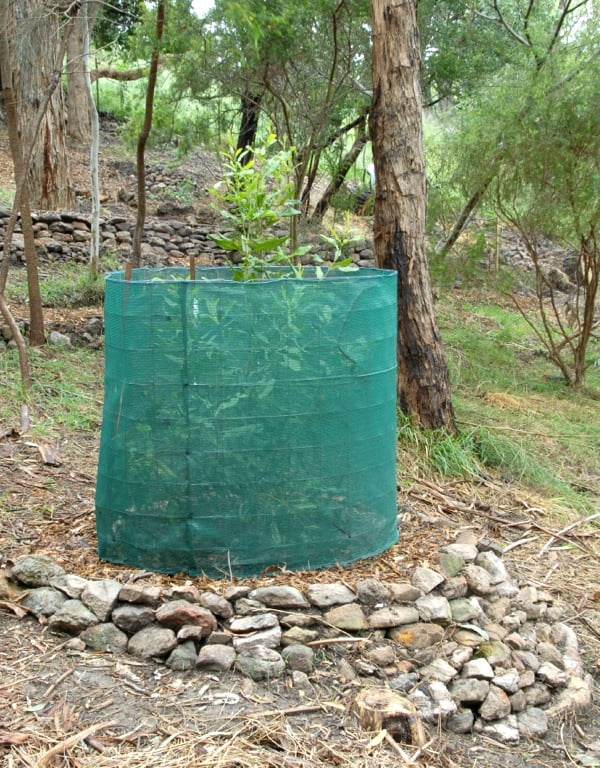
The transplanted macadamia settles into its new home
My macadamia had been in for three seasons and was growing well on the south side of the house. It wasn’t getting much light, especially in winter, but I hoped that when the tree grew taller and out of the shade, it would get enough sun to crop well. When we bought the new area, I realised I could give it a much better spot. However, if I were to have any chance of success, I had to transplant that macadamia within the next few months, ie in spring. The tree would be bigger and trickier after another growing season. It would be touch-and-go as it was – an evergreen native that had been in position for three years – but it was a cutting-grown cultivar with a fibrous root system, not a seedling with a tap root, and I’d prepared the soil extremely well when I’d planted it, so I had a large area of friable soil that should be easy to excavate.
My ‘Ettinger’ and ‘Hass’ avocados had been in for three seasons and one season respectively. Again, I’d prepared the soil carefully, digging in cheap potting mix and good compost, so hopefully excavating them should be straightforward. That spring was the best time to transplant them too but, unfortunately, the place they were to go in the new area was covered by twelve cubic metres of mulch! So I couldn’t move them straight into position: instead, I’d have to pot them into containers until the mulch was moved and the area was clear, probably by the following autumn. But transplanting in autumn wouldn’t work with my region’s winters, so I’d need to nurse them in containers in a warm spot through the cold and wet until the following spring – another iffy proposition.
Still, I had nothing to lose. My neighbour’s photinia hedge to the north of the avocados’ current position would soon block out all direct sunlight, so they wouldn’t ever fruit anyway.
For the next month, I watered the trees and soil around them weekly with Seasol with the aim of strengthening their root systems and improving the health of the surrounding soil. Seasol reportedly increases the structural strength of plant cell walls – I don’t know if that’s true but, from experience, my potted trees do seem to be more resistant to wilting in hot weather when I’ve treated them regularly in spring with Seasol, though my observation is anecdotal and not scientific.
I also gave the trees less than one quarter of their normal fertilising regime – just a sprinkle of Osmocote for Natives for the macadamia, and another sprinkle of Complete Manure D for the avocados, and no manure and Rapid Raiser at all – because the last thing I wanted was for them to put on a huge flush of soft growth that would only wilt at transplanting.
There’s also a product called ‘Stress Guard‘ that you spray onto leaves before transplanting. It seals the leaf surface, reducing evapotranspiration until the leaves start growing again, when the film deteriorates. I’ve heard it’s extremely effective but I didn’t use it because I didn’t remember it until afterwards!
First I dug the avocados in late winter. I’d added three very large 70L bags of potting mix to each planting hole, and the area they were in had sand added at some time in the past, so the soil wasn’t the characteristic clay of the rest of the block. The young one with the small rootball was easy. I put it in the largest plastic pot I could find and back-filled with premium potting mix. In dappled shade, it didn’t even wilt. Hooray!
The other wasn’t so successful, mainly because I decided to add a bit of water during the digging process because the soil looked dry. Big mistake – the rootball became so heavy that, as I levered it out, about a third broke away. I also had to trim the rootball quite a bit to fit into the pot. I consoled myself with the thought that the tree was a waste of money where it was, anyway.
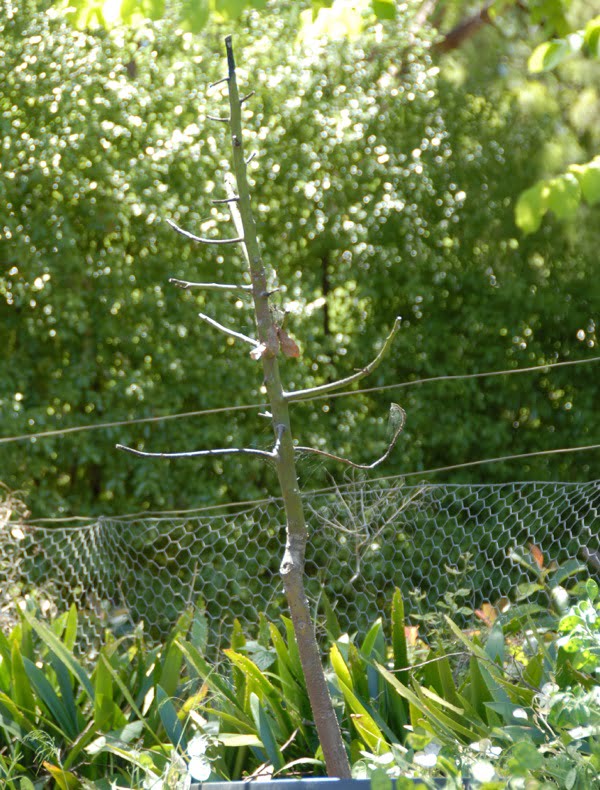
Dropped leaves and blackening branches – worrying signs that this avocado transplant is not going well
Soon, the tree dropped all its leaves. The branches shrivelled and blackened.
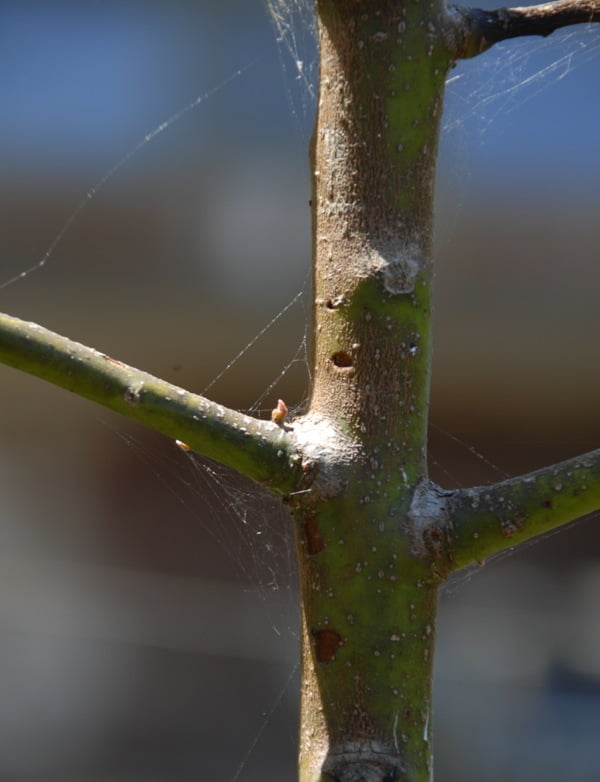
Tiny new buds in mid spring give me hope the transplanted avocado might survive after all
But I persevered and kept watering it (only after the surface few centimetres became dry – I didn’t want to waterlog the pot), and then, about a month later, I noticed tiny buds appearing from the trunk!

With lots of TLC, by mid summer the transplanted avocado has lots of healthy new growth
By mid summer it had plenty of healthy new growth. I’m not in the clear yet – keeping them going for a whole year in pots, especially over winter – will be challenging, but I’ve done it before with plants like guavas against the northern (sunny) wall of my house, under the house eaves so they don’t get too wet. Because the soil I planted them into had such a large proportion of potting mix, the pots are draining freely – essential for avocados that succumb to root rot at the drop of a hat. Before winter, I’ll cut extra holes in the bottom of the pots, too, and raise them above the paving to give them the best possible chance.
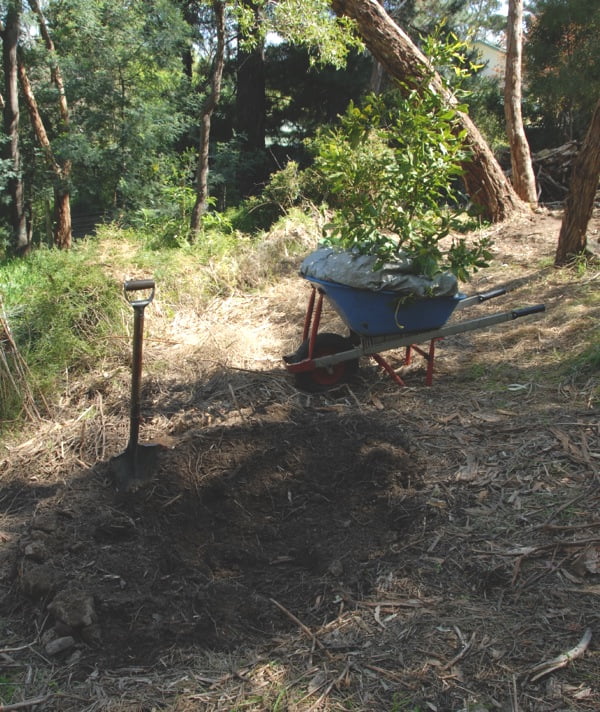
Preparing a planting spot for the transplanted macadamia on the new block
Next, the macadamia. I prepared the planting hole in the new block, digging over a circle 1.5m (5 feet) in diameter, adding lots of compost and several bags of budget potting mix. This very effective method for planting evergreen subtropical fruit trees is one I learned from Chris Perry (of Perry’s Fruit and Nut Nursery). As well, I raised the lower side of the slope with a dry stone retaining wall half-circle so I wasn’t creating a sump but a mound. This way the surface wouldn’t slope, and I could create a shallow basin on the surface for watering. I wanted the area to be as large as possible so the tree could get a good start without root competition from nearby stringybarks. I watered the macadamia thoroughly two days in advance of a forecast cool day towards the end of mid spring, then dug it out with a long-handled spade.
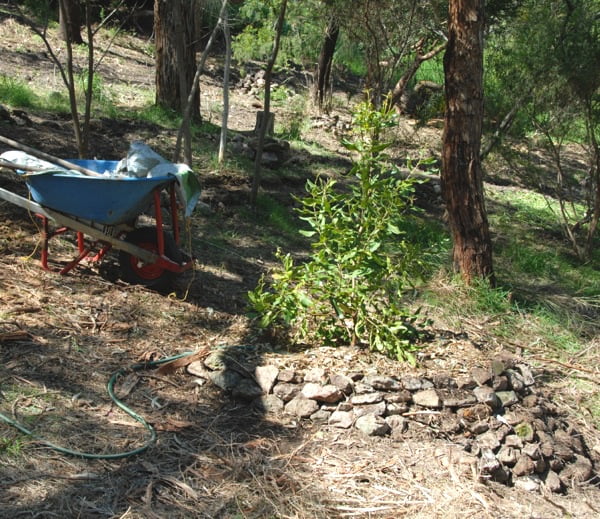
Using rocks to create a supporting half-circle mound and shallow watering basin for the transplanted tree on the sloping site
Well, that sounds straightforward but it was a three hour job, starting with digging a deep trench around the tree and working inwards from there, and in the end I had to enlist Geoff’s help because the size of the rootball – a wide, shallow bowl shape – meant that it was too heavy for me to move, let alone lift. We manoeuvred a tarpaulin underneath, tied it around the rootball, and laid the wheelbarrow on its side next to the tree. Then we wiggled and pulled it across into the barrow, and together slid it vertical as we simultaneously got the barrow upright. It was incredibly heavy. Then with lots more heaving, pulling, shoving and swearing, we got the wheelbarrow up the bank and steps to the new spot, and basically reversed the process. I backfilled the hole, firmed down the soil and mulched with wood chip mulch (keeping the mulch away from the trunk). Then I watered it VERY thoroughly with a hose until the water started draining out through the rock wall. The last step was to place a home-made shade cloth tree guard about a metre (3ft) high and 1.2m (4ft) in diameter around the tree to protect it from hot wind and sun in its first season – another excellent recommendation from Chris Perry.
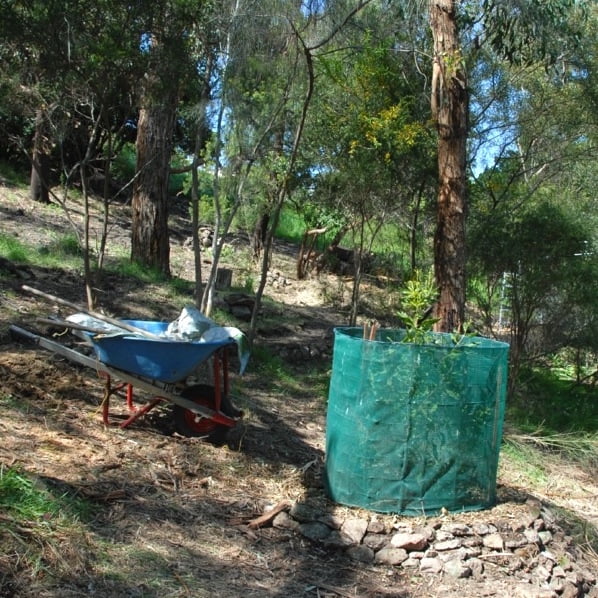
Transplanted macadamia surrounded by protective shade cloth
I waited with bated breath. The new tip growth wilted that afternoon, but I was thrilled to see that it had perked up by the evening… and it didn’t look back. To my absolute amazement I didn’t lose a single leaf and the tree hasn’t missed a step. I planted a second macadamia – a pink flowering form – nearby because, although they’re self-fertile, they tend to fruit better when cross-pollinated.
In fact, both trees did so well that in mid-summer I removed the tree guards – the garden is sheltered from hot northerly winds, and the trees are protected from late afternoon sun, so I felt they would do better with the extra light. Both trees have put on plenty of new growth. Neither tree is in full sun, but there is an old shrubby acacia to the north of them that I doubt has many years left in it (I removed three dead ones of the same vintage and species when clearing the block). I’ll prune the acacia a little in early winter, and I think the macadamias will be fine.

By late summer, the macadamia has vigorous new growth
I want to transplant the persimmon too, but they have notoriously brittle root systems. Still, I’ll give it a go down the track, and I’ll seek advice from Chris Perry first.
Many garden experts will tell you that you can’t transplant Australian native species or many trees and that may be true for most, especially seed-grown ones, but perhaps like me you have nothing to lose because the tree will fail or is failing anyway in its current position. Perhaps you’ve had a fruit tree in an unsuitable spot and it’s never fruited – if you’ve tried soil improvement and fertiliser and nothing’s worked, why not cut it back and/or root prune first, and then try transplanting? It’s a good idea to contact your local specialist nursery for advice beforehand – a particular time of year is often ideal, or certain plants may have special requirements – but sometimes, it’s worth just giving things a go, and seeing what happens!
